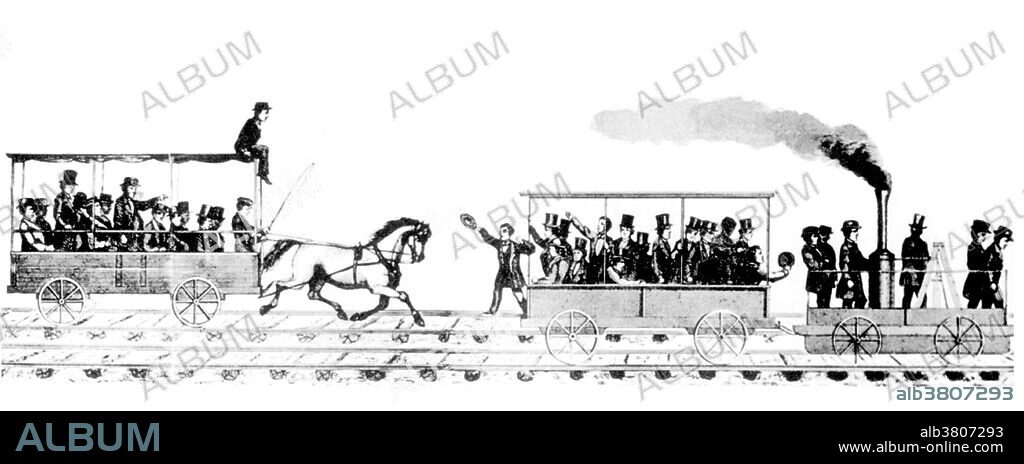alb3807293
"Tom Thumb" Races Stagecoach, 1830

|
Add to another lightbox |
|
Add to another lightbox |



Buy this image.
Select the use:

Title:
"Tom Thumb" Races Stagecoach, 1830
Caption:
Tom Thumb was the first American built steam locomotive to operate on a common-carrier railroad. Designed and constructed by Peter Cooper in 1830, it was built to convince owners of the newly formed Baltimore and Ohio Railroad (B&O) to use steam engines and not intended to enter revenue service. Testing was performed on the company's track between Baltimore and Ellicott Mills. Two tracks had been constructed, which led the owners of Stockton and Stokes stagecoach company to challenge the locomotive to a race and on August 28, 1830, the race was held. The challenge accepted, Tom Thumb was easily able to pull away from the horse until the belt slipped off the blower pulley. Without the blower, the boiler did not draw adequately and the locomotive lost power, allowing the horse to pass and win the race. However, the demonstration was successful; and in the following year, the railroad committed to the use of steam locomotion and held trials for a working engine.
Category:
ILLUSTRATION • black & white • TRANSPORTATION • Science: History
Credit:
Album / NYPL/Science Source
Releases:
Image size:
5400 x 2170 px | 33.5 MB
Print size:
45.7 x 18.4 cm | 18.0 x 7.2 in (300 dpi)
Keywords:
1830 • 1830S • 19TH CENTURY • AMERICA • AMERICAN • ART • ARTWORK • AUGUST 28 • AUGUST 28TH • BALTIMORE • BLACK & WHITE • BW • CELEBRITIES • CELEBRITY • CIVIL ENGINEERING • COMMON-CARRIER RAILROAD • DESIGN • DRAWING • ENGINEERING • FAMOUS PEOPLE • FAMOUS • HISTORIC • HISTORICAL • HISTORY • ILLUSTRATION • ILLUSTRATIONS • IMPORTANT • INVENTION • LOCOMOTIVE • MACHINE MANUFACTURING • MARYLAND • MECHANICAL ENGINEERING • NOTABLE • PASSENGER • PASSENGERS • PEOPLE • PULGARCITO • RACE • SCIENCE • SCIENCE: HISTORY • STAGECOACH • STEAM DRIVEN • STEAM ENGINE • STEAM LOCOMOTIVE • STEAM POWERED • STEAM TURBINE • STEAM-DRIVEN • STEAM-ENGINE • STEAM-POWERED • STEAMENGINE • STOKES STAGECOACH COMPANY • TECHNOLOGICAL • TECHNOLOGY • TOM THUMB • TRAIN • TRANSPORTATION • UNITED STATES • US • USA • VEHICLE • WELL-KNOWN
 Pinterest
Pinterest Twitter
Twitter Facebook
Facebook Copy link
Copy link Email
Email
